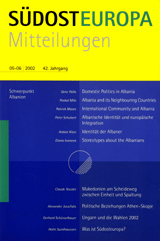Identitätsverständnis und konkrete Identität der Albaner
How to Interpret Identity and the Objective Identity of the Albanians
Author(s): Ardian KlosiSubject(s): Politics / Political Sciences
Published by: Südosteuropa Gesellschaft e.V.
Summary/Abstract: In this essay the author likes to differentiate between identity as a self-image and the concrete „objective“ identity of the Albanians in their everyday life. The first one is forged and trained through books, newspapers, media, and propaganda, the second one is more unconscious and instinctive, it expresses itself in the everyday activities of people. The image Albanians had of themselves was more or less clear before 1990. It was the image conveyed through the propaganda of the communist regime, which represented Albanians as a very old population, living in the same place since the antique under the name of the lllyrians. As lllyrian-Albanians they had to endure a series of occupations: from the old Rome to the Ottoman Empire, to Mussolini‘s Italy and so forth. The Albanians had suffered injustice through the centuries (they had never applied it on other nations). This image was reinforced even through scientists or writers like Ismail Kadare, who had a good reputation abroad otherwise. Beside of this, the virtues of the Albanians and the quality of their lives was much praised all the time. With the collapse of the regime the Albanians were confronted with quite another reality abroad and at home. They realised that they were the poorest and the most backward nation in Europe. Their sufferance made them often hate their own country and culture. Hundreds of thousands left Albania to live in the West. A lot of them do not come back to their land, they even change their family language. The self-image and the concrete identity of the Albanians is analysed below in four groups of the population: 1. in the low and middle classes of Albania itself, 2. in the Albanian Diaspora abroad, 3. in the intellectual elite of the country and 4. amidst young people of schools and universities. The author comes to different conclusions concerning these groups and in comparison to past manifestations of the phenomenon.
Journal: Südosteuropa Mitteilungen
- Issue Year: 2002
- Issue No: 5-6
- Page Range: 34-41
- Page Count: 8
- Language: German
- Content File-PDF

